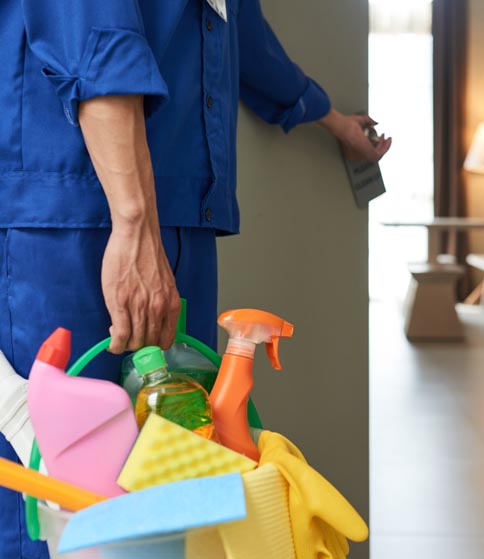
Janitorial Training: Safe Handling Of Cleaning Products
They’re the unsung heroes who keep schools, offices, restaurants, hospitals and other frequented places clean and sanitary. Janitors work hard and put themselves at greater physical risk than some would imagine.
Janitors and cleaners sustained 19,097 injuries while at work in 2018, according to the most current U.S. Bureau of Labor Statistics (BLS) data. This includes 320 incidents involving chemicals from the cleaning products they come into contact with every day.
How can you keep janitors and cleaning staff safe when using cleaning products?
The Dangers
Cleaners, sanitizers and disinfectants are the tools of the trade, but they are not one in the same. In general, disinfectants and sanitizers are more hazardous than cleaners.
According to the Occupational Safety And Health Administration:
- Cleaners remove dirt through wiping, scrubbing or mopping.
- Sanitizers contain chemicals that reduce, but do not totally eliminate, bacteria, viruses and molds from surfaces.
- Disinfectants contain chemicals that destroy or inactivate microorganisms that cause infections.
Often, the chemicals in these products are caustic, flammable or poisonous. They can irritate the skin and cause rashes and burns.
Vapors and gasses from these chemicals can irritate or burn the eyes, nose, throat or lungs and cause coughing, wheezing, trouble breathing, sore throat, headaches, nosebleeds, dizziness and trigger asthma attacks.
Long-term exposure to some chemicals can cause cancers and other health problems.
Safe Handling
Janitorial services company owners and employees play an important role in ensuring the safe handling of cleaning products.
As owners and managers, you need to provide safe workplaces with good ventilation for janitors who use cleaning chemicals. You should also provide the right personal protective equipment (PPE), which at minimum includes protective clothing, gloves and safety goggles.
OSHA recommends custodial businesses develop and regularly use janitorial training programs to teach front-line workers how to safely handle cleaning products. OSHA says janitorial safety training should:
- Caution workers not to mix cleaning products
- Ensure workers know which cleaning chemicals must be diluted and how to do so correctly
- Review and train workers on the use and storage of chemicals and cleaning agents
- Review and train workers on emergency spill procedures
- Review and provide the proper PPE
- Ensure all containers of cleaning products and chemicals are labeled correctly to identify their contents, hazards and expiration dates
- Run ventilation systems as needed during cleaning tasks to create sufficient air flow and prevent the buildup of harmful vapors
- Provide workers with a place to wash up after using cleaning chemicals
Importantly, you must also maintain Safety Data Sheets (SDSs) for all hazardous chemicals and cleaning products you use and keep SDSs readily available for workers.
According to OSHA, SDSs should list hazardous chemicals in the cleaning products; potential health issues and symptoms associated with chemicals in the cleaning products; related first-aid measures for exposure; the right PPE to employ when using the chemical; and the correct clean-up procedures for spills.
Proper Use
After cleaning staff training, janitors must use cleaning products responsibly. They must treat all chemicals and cleaning products carefully and with respect, reading labels and following directions for using the products safely.
When products call for dilution, they must use the chemicals exactly as directed by the label’s instructions and not overuse concentrates in an attempt to create a “stronger” cleaning product.
Cleaning products should also never be used to wash the hands or body parts, but proper hand washing is mandatory after using cleaning chemicals, especially before eating, drinking or smoking.
Notably, janitors must never mix different cleaning chemicals together, as it could create dangerous chemical reactions and release hazardous gases.
Bleach, one of the most common household and industrial cleaning products, poses a particular danger. When mixed with ammonia, it creates mustard gas. Bleach also creates other harmful gases when mixed with glass/window cleaners, chlorinated powder cleansers, drain cleaners, hydrogen peroxide, chlorinated disinfectants and vinegar.
Proper Storage
While owners need to keep track of SDSs, janitors need to know how to correctly and safely store chemicals and cleaning supplies.
Storage areas should be well-ventilated and kept cool. Stacking boxes and containers too high is hazardous, and powders should be stored above liquids. Within storage areas, cleaning products and chemicals should be kept out of direct sunlight and out of the reach of children.
Janitors on break should not eat, drink or smoke near stored chemicals and cleaning supplies. Nor should they store food and beverages alongside chemicals and cleaning products.
Proper Practices and Equipment
Finally, OSHA recommends that you investigate and invest in new cleaning practices and cleaning equipment that reduces the reliance on chemicals to keep spaces clean and sanitary. These include microfiber mops, cloths and dusters; chemical-free or green cleaning products and systems; high-filtration HEPA vacuums; hands-free mops; and preventative measures, such as mats inside and outside of buildings to keep out tracked dirt.
There are more than 19,000 health-and-safety-related incidents annually, making janitorial work deceptively dangerous. The costs for workers’ compensation claims can quickly cut into your bottom line if you don’t run safe operations.
